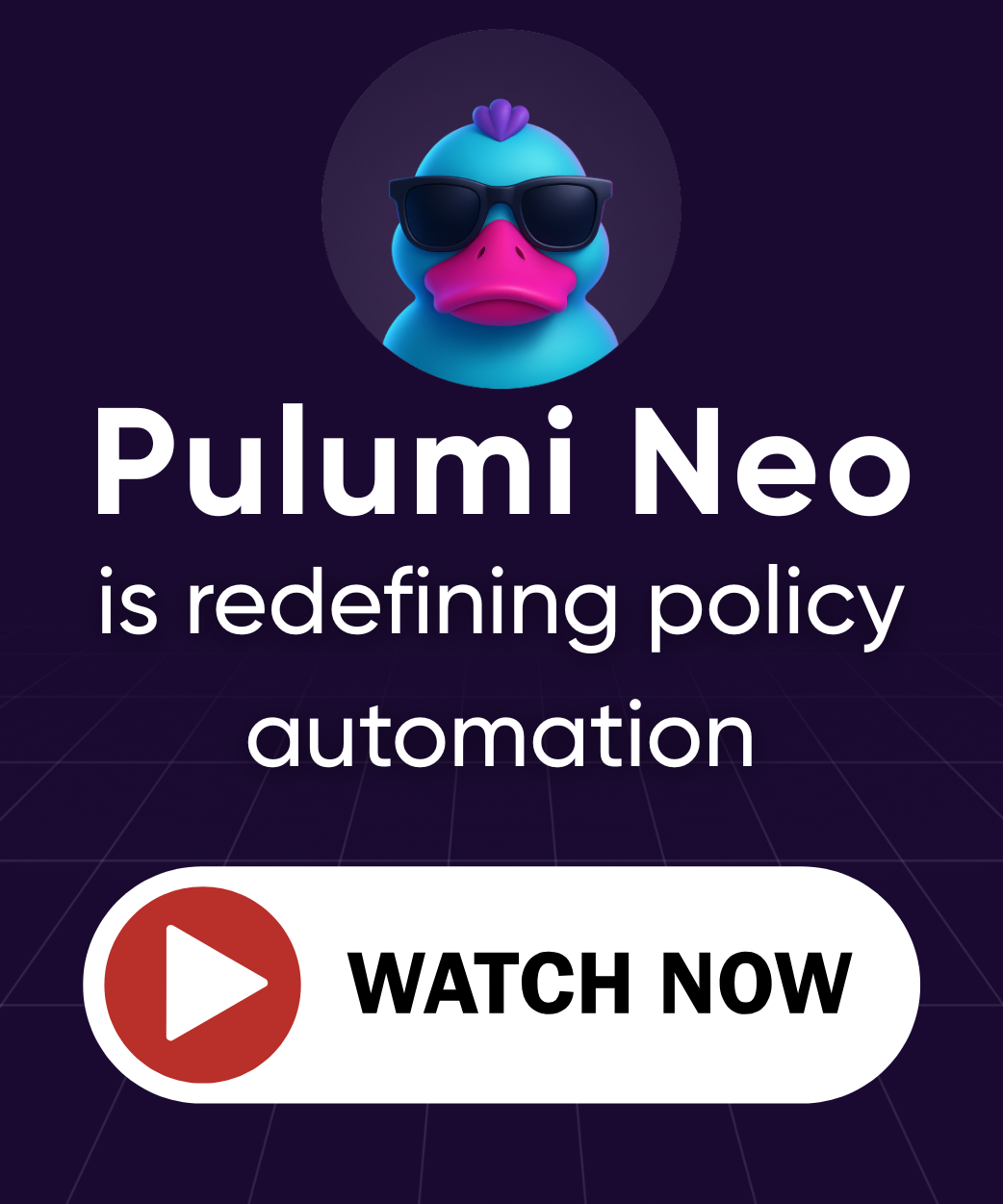Backstage vs Pulumi IDP: Why Infrastructure-First Wins!
Posted on
Developers are losing days every month to infrastructure bottlenecks, compliance hurdles, and inconsistent environments. Platform engineering promised to fix that, yet too many platforms fail before they deliver real impact.
In this comparison of Backstage vs Pulumi IDP, we’ll explore why choosing the right architectural approach matters more than the tool itself.
Quick comparison: Backstage vs Pulumi IDP
Backstage is an open-source developer portal framework from Spotify that focuses on service catalogs and documentation. It requires significant setup time (12-18 months) and ongoing maintenance (3-5 FTEs).
Pulumi IDP is an infrastructure-first internal developer platform that embeds governance, cost control, and security from day one. It can be deployed in hours with minimal ongoing maintenance.
The problem isn’t whether you choose Backstage or Pulumi IDP. The real question is: Will your platform treat infrastructure as a first-class concern, or as an afterthought?
According to Gartner, 80% of large enterprises will deploy internal developer platforms within the next two years. But without a strong infrastructure foundation, those platforms risk becoming expensive, hard-to-maintain bottlenecks instead of accelerators.
Why platform engineering efforts fail: Common mistakes
Platform teams consistently make four critical mistakes:
Neglecting Infrastructure Foundations
Over-focusing on the developer portal experience while letting infrastructure governance and scalability lag behind.Ignoring Cost Efficiency
Prioritizing productivity at the expense of cloud cost management.
Example: One company considered giving every developer their own cluster, a scaling nightmare both technically and financially.Treating Security & Governance as Add-Ons
Bolting on compliance after launch leads to constant firefighting and security debt.Building for Yesterday’s Architecture
Designing general-purpose platforms that can’t keep up with Kubernetes-native workloads.
Portal-first vs infrastructure-first platform engineering
There are two dominant approaches:
- Portal-First typified by Backstage, which starts with developer experience and service catalogs.
- Infrastructure-First exemplified by Pulumi IDP, which builds the platform foundation around scalable, policy-driven infrastructure.
| Platform Engineering Feature | Backstage (Portal-First) | Pulumi IDP (Infrastructure-First) |
|---|---|---|
| Primary Focus | Developer portal & catalog | Scalable, policy-driven infrastructure |
| Setup Time | 12-18 months | Hours |
| Maintenance | 3-5 FTE ongoing | Minimal ongoing overhead |
| Infra Provisioning | Requires separate tooling | Built-in |
| Cost Awareness | Depends on infra layer | Native |
| Security & Governance | Add-on | Built-in from day one |
Backstage: The portal-first platform engineering approach
Backstage is an open-source framework for building developer portals. Originally built by Spotify, it excels at unifying tools, services, and documentation.
Strengths
- Mature Ecosystem with over 1,200 integrations and a large community.
- Excellent Service Catalog providing centralized metadata, ownership, and discovery.
- Docs-as-Code that keeps documentation close to the codebase.
- Self-Service Templates that standardize scaffolding for new projects.
Challenges
- High Maintenance Overhead requiring 3-5 FTEs just to keep it running in large orgs.
- Complex Setup with Yarn version headaches, TypeScript complexity, plugin upkeep.
- Infra as an Afterthought that lacks built-in provisioning, often pushing infra concerns down the road.
- Hidden Costs resulting in multi-million dollar TCO over three years for a 300-dev team when factoring in staffing and infra complexity.
Pulumi IDP: the infrastructure-first platform engineering approach
Pulumi IDP brings Infrastructure Platform Engineering (IPE) to the forefront by embedding scalable, secure, cost-aware infrastructure into the platform from day one.
Strengths
- Infrastructure as a First-Class Concern with built-in multitenancy, isolation, and governance.
- Efficiency & Cost Awareness through golden paths and reusable components optimized from the start.
- Policy-Driven by Design that enforces security, compliance, and cost policies automatically.
- Cloud-Native Ready ideal for ephemeral workloads, Kubernetes, and multi-cloud.
Considerations
- Newer Platform with a smaller plugin ecosystem than Backstage’s.
- Infra-Heavy Focus that’s best fit for infra-intensive orgs; overpowered if you only need a catalog and docs.
Real-world platform engineering outcomes: Backstage vs Pulumi IDP
Pulumi IDP Adoption: CLEAR leveraged Pulumi IDP’s prebuilt capabilities instead of building infra automation from scratch, speeding up delivery while keeping governance tight.
Backstage vs Pulumi IDP decision guide
When to choose Backstage
Choose Backstage for platform engineering if you:
- Have a dedicated platform team with strong React/TypeScript skills
- Primarily need service cataloging and documentation
- Already have robust infrastructure provisioning and governance tools
- Have 18+ months and budget for ongoing maintenance (3-5 FTEs)
When to choose Pulumi IDP
Choose Pulumi IDP for platform engineering if you:
- Need infrastructure governance from day one
- Want cost management and policy automation built in
- Must scale efficiently across Kubernetes and multi-cloud
- Prefer to avoid building everything from scratch
- Need to deploy quickly (hours vs months)
The shift to infrastructure platform engineering (IPE)
Platform engineering isn’t failing because the idea is flawed. It’s failing because too many efforts start with the portal and leave infrastructure for later.
Infrastructure Platform Engineering flips that model, ensuring the platform’s foundation is:
Hybrid approaches are also possible. Pulumi offers a Backstage plugin so teams can pair Backstage’s portal features with Pulumi IDP’s infrastructure power.
Bottom line: infrastructure-first wins for platform engineering
If your platform is slow, costly, or hard to govern, it’s not a developer problem. It’s an infrastructure problem. Treating infrastructure as a first-class concern from day one isn’t optional. It’s the difference between a platform that scales and one that stalls.
Frequently asked questions
What is the main difference between Backstage and Pulumi IDP?
Backstage is a portal-first developer platform that focuses on service catalogs and documentation, requiring separate tools for infrastructure provisioning. Pulumi IDP is an infrastructure-first platform that embeds governance, cost control, and infrastructure automation from the start.
How long does it take to implement Backstage vs Pulumi IDP?
Backstage typically requires 12-18 months for full implementation with ongoing maintenance by 3-5 FTEs. Pulumi IDP can be deployed in hours with minimal ongoing maintenance overhead.
Can I use Backstage and Pulumi IDP together?
Yes, Pulumi offers a Backstage plugin that allows teams to combine Backstage’s portal features with Pulumi IDP’s infrastructure capabilities for a hybrid approach.
What are the costs of running Backstage vs Pulumi IDP?
Backstage’s TCO for a 300-developer team can reach multiple millions over three years when factoring in staffing and infrastructure complexity. Pulumi IDP has lower operational costs due to built-in automation and minimal maintenance requirements.
Which platform is better for Kubernetes environments?
Pulumi IDP is purpose-built for cloud-native and Kubernetes environments with built-in support for ephemeral workloads and multi-cloud deployments. Backstage requires additional tooling for Kubernetes infrastructure management.
Learn more about Pulumi IDP and how infrastructure-first platform engineering avoids common failure patterns.

